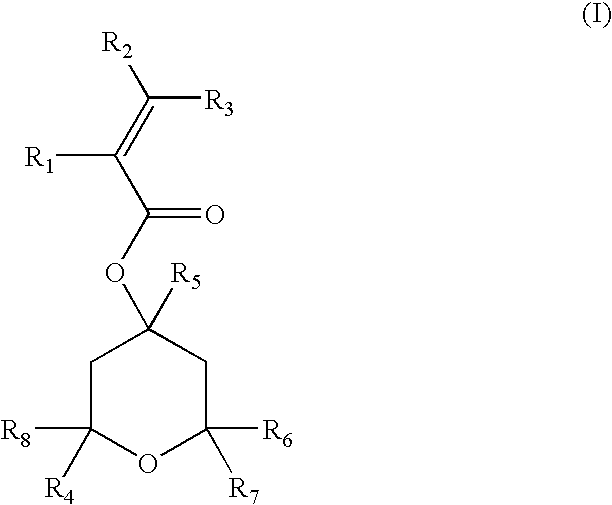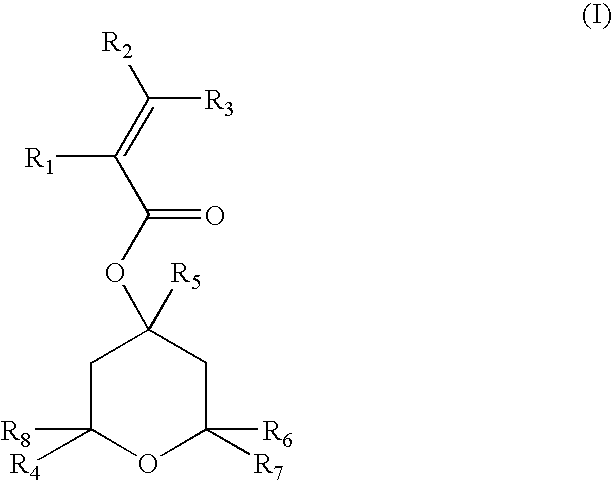Acrylic compounds for sub-200 nm photoresist compositions and methods for making and using same
- Summary
- Abstract
- Description
- Claims
- Application Information
AI Technical Summary
Benefits of technology
Problems solved by technology
Method used
Image
Examples
example 1
Preparation of 4,6-dihydroxy-2-methyl-2,4,6-tris(trifluoromethyl)-tetrahydropyran
[0047]In a 500 mL three-neck round bottom flask equipped with a teflon stirrer, a thermocouple and a nitrogen inlet, 88 mL of a 1M THF solution of potassium tert-butoxide were cooled to a temperature ranging from −30° to −50° C. A 40 mL quantity of trifluoroacetone was slowly added to the flask to form a reaction mixture and the reaction mixture was allowed to warm up to room temperature. After four hours, the reaction mixture was poured onto a dilute solution of hydrochloric acid and the aqueous layer was extracted with ethyl ether. The combined organic layers were dried and filtered and the solvent was evaporated to provide 36 grams of a white solid product after recrystallization from a hexane solvent. The percentage yield of the product was 73%. An analysis of the product identified it as 4,6-dihydroxy-2-methyl-2,4,6-tris(trifluoromethyl)-tetrahydropyran (four stereoisomers, one major). The mass spe...
example 2
General Procedure for the Acylation Reactions; Preparation of 4,6-hydroxy-2-methyl-2,4,6-tris(trifluoromethyl)-tetrahydropyran-4-acrylic acid ester
[0048]In a 500 mL three-neck round bottom flask equipped with a teflon stirrer, a thermocouple and a nitrogen inlet, a solution containing 50.26 g of 4,6-dihydroxy-2-methyl-2,4,6-trifluoromethyl-tetrahydropyran (prepared in accordance with Example 1) and 45.7 mL of N-ethyl morpholine in 150 mL of THF was cooled to −15° C. An acylating agent, acryloyl chloride (14.5 mL), was slowly added to form a reaction mixture and the reaction mixture was allowed to warm up to room temperature. After four hours, the reaction mixture was poured onto a dilute solution of hydrochloric acid and the aqueous layer extracted with ethyl ether. The combined organic layers were dried and filtered and the solvent evaporated to provide 47 grams of a white solid product after recrystallization from hexane. The percentage yield of the product was 80.5%. An analysis ...
example 3
General Procedure for the Deoxofluorination Reactions; Preparation of 6-fluoro-4-hydroxy-2-methyl-2,4,6-tris(trifluoromethyl)-tetrahydropyran 4-acrylic acid ester
[0049]In a 50 mL three-neck round bottom flask equipped with a teflon stirrer, a thermocouple and a nitrogen inlet, a solution of 3.9 g of 4,6-dihydroxy-2-methyl-2,4,6-trifluoromethyl-tetrahydropyran-4-acrylic acid ester (prepared in accordance with Example 2) in 8 mL of ethyl ether was slowly added to a cooled solution of bis(2-methoxyethyl)aminosulfur trifluoride (2 mL) in 8 mL of ether to form a reaction mixture. The reaction mixture was allowed to warm up to room temperature. After one hour, the reaction mixture was poured onto a solution of sodium bicarbonate and the aqueous layer was extracted with ethyl ether. The combined organic layers were dried, filtered and the solvent evaporated to give 3.2 g of an oil. The percentage yield of the product was 78%. An analysis of the oil determined that it was 6-fluoro-4-hydroxy...
PUM
| Property | Measurement | Unit |
|---|---|---|
| Fraction | aaaaa | aaaaa |
| Fraction | aaaaa | aaaaa |
| Temperature | aaaaa | aaaaa |
Abstract
Description
Claims
Application Information
 Login to view more
Login to view more - R&D Engineer
- R&D Manager
- IP Professional
- Industry Leading Data Capabilities
- Powerful AI technology
- Patent DNA Extraction
Browse by: Latest US Patents, China's latest patents, Technical Efficacy Thesaurus, Application Domain, Technology Topic.
© 2024 PatSnap. All rights reserved.Legal|Privacy policy|Modern Slavery Act Transparency Statement|Sitemap



